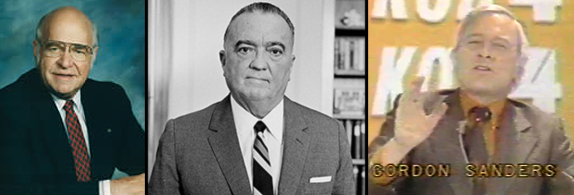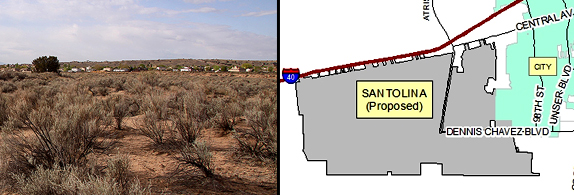Political Blackmail

Surveillance, spying, dumpster diving, clandestine photography, holding back blotter reports on embarrassing moments in people’s lives and threatening to use them if they don’t keep in line, dossier building on politicians and prominent business people -- this has been going on in the Duke City for decades. The dreadful specter of bulldog J. Edgar Hoover and his FBI blackmail tactics is a well-known secret in our town.
The l981 mayoral election which pitted radio commentator Gordon Sanders against former Mayor Harry Kinney proved to be a very early foretaste of Tea Party politics in New Mexico, but one tainted by the threat of blackmail. This was one of the whackiest elections in modern Albuquerque history. It featured not only a mad-cap candidate with an uncanny sense of political opportunism, but also a wonderful example of what happens when operatives of a bozo wanna-be local police state try to intimidate candidates and it all goes haywire.
Gordon Sanders won a shocking victory in a mayoral primary against sitting mayor David Rusk, a progressive democrat who brought some class, if not political acumen, to City Hall. Sanders was considered a political neophyte and posturing clown. But when the dust settled, some 23,000 Albuquerqueans had voted for him. Former Mayor Kinney, trying to make a political comeback, took second to face Sanders in a runoff. David Rusk, to the hand-wringing disbelief of many, took an inexplicable third place. In hindsight it was one of the early examples of hapless New Mexico Democrats losing elections they should have won with no trouble at all.
In a preprimary interview with Century Magazine, Gordon Sanders told me “As President Reagan is trying to dismantle the federal bureaucracy, I am trying to dismantle the bureaucracy of City Hall.” He attacked Mayor Rusk, saying that “The idea that city government should plan the city is wrong.” Rusk, he said, “came here with preconceived notions of how a city should be built, whereas cities are the product of evolutionary processes that cannot be doctored by overlays of technology, planning, industry….The planning department has too many people or they are not doing their job.” Sanders was a tea party Republican long before anyone thought up the Rio Grande Foundation.
Harry Kinney, a Sandia Lab engineer, was also what one might call a professional politician who some said was so familiar with Albuquerque he knew where every manhole cover in the city was. He made mincemeat of Sanders in the general election.
And he did so despite the deafening buzz of gossip about a supposed early transgression on Kinney’s record, one that had been kept secret a long time by police higher-ups who everyone suspected had pulled a pink blotter report from the desk years ago and hid it in a strong box.
The blotter report apparently recorded an incident of alleged Peeping Tomism on the part of former Mayor Kinney when he was a kid. There was nothing secret about the blotter report’s existence. In fact numerous news people claimed to have a copy of the report. When I finally saw a copy, weeks before the l981 election, it was a Xerox of Xerox of a Xerox and verging on the illegible. It might as well have been completely redacted.
But, in the true spirit of political opportunism, Gordon Sanders got a copy of the blotter report himself. This, he must have thought, would surely seal Harry Kinney’s fate. But when he waved around the piece of paper declaring its contents in his most theatrical manner, no one paid any attention at all. The blotter report, hidden for years to be sprung at exactly the right moment, bounced off Kinney like a hand grenade off Superman’s chest. And that was that.
One wonders how many other little bits of nasty human droppings have been buried away by law enforcement spies over the years, and one wonders, too, what’s going on in the deep dark recesses of the so-called Criminal Intelligence Unit at the current APD. So is this a “unit” of, or with, criminal intelligence? Who’s to tell? An excellent rundown on the history of such snooping here appears in the current issue of ABQ Free Press by Peter St. Cyr.
This stuff’s really got to stop. Why are police collecting information on people who haven’t broken the law instead of chasing down murderers and bandits and muggers and domestic abusers and armed robbers? Why do so many property crimes go unsolved? Why do so many violent crimes against women go unsolved?
Why are police collecting criminal intelligence instead of the criminals themselves?
I wonder if there are ever any answers.
Santolina: Retro Sprawl

The proposed Santolina development south of I-40 running from near the edge of the city to the Rio Puerco over some 55,000 acres is an idea whose time has come and gone years ago. Santolina is caught in a time warp of the l950s and l960s and has fallen, as well, into the general information sink that has swallowed up news about the reality of New Mexico almost since statehood.
Big banks that support the idea apparently know nothing about Albuquerque, about our drought, about the general impact of climate change on our state and region, nor about our still abysmal business climate and the wretched poverty that so many New Mexicans are forced to endure.
When we read of plans for a community of 90,000 people with 75,000 jobs many of us scratch our heads in dumbfounded disbelief. Where do these developers think this is, Los Angeles County? Where are these 90,000 people going to come from? How can anyone promise 75,000 jobs when New Mexico is the only state in country that is losing employment? Where will these jobs come from?
Why can’t the Mariposa development in northern Rio Rancho fill itself up with new housing? Why can’t Mesa del Sol, with all its backing and jobs, fill up with housing? Why hasn’t Campbell Ranch, a development near the East Mountains, filled up with housing? Why are we still in a construction slump? What would Santolina do to change that? Nada, that I can see.
Bernalillo County is considering approving the Santolina master plan. Why the County would approve such an anachronistic idea out of the distant past I do not know. We are living in an age of infill development, not sprawl development. We are living in an age of using and repairing existing infrastructure not demanding new structural systems and overusing old ones. Actually, to be more precise, we are living in an age of no development at all, or at least it seems so at this moment in time. Santolina says it’s going to use 143,000 acre feet of water. The entire city gets 148,000 acre feet from the San Juan Chama Project. And we might not get any of that water in the future given the Colorado River Basin’s on-going 14 year drought.
Where do Santolina developers think they’ll get that 143.000 acre feet of liquid, not paper, water? Are they planning to melt a glacier somewhere or just shuffle around the documents and pretend it’s the sound of running water?
Michael Jensen of Amigos Bravos comments wisely on Santolina in the July issue of La Montañita Co-op Connection:
Developers are always among the most powerful political forces at the local level. But the interests of developers, which hinge on constant expansion of land acquisition and building, are not inherently the same as the interests of the wider community. In other words, developers do not necessarily promote healthy and sustainable development. It is, therefore, both unsurprising and disturbing that at least some County planners and officials have said that, “We owe the developer something.”…The investors behind Santolina are taking a risk; that’s their choice. The County owes the developers, as landowners in the County, only a process to hear their plan. The County does not owe the developers a particular outcome. The County owes all the rest of us a process that takes all of our needs into consideration, that takes a holistic and long-term approach, and then assesses whether a particular plan makes sense for the entire community.
Now is not the time to force an old vision of the world, a vision of abundance and “inevitable growth,” on a city struggling, sometimes blindly, to face the future rushing upon it. We are in the early years of an undeniable and massive transition in urban conditions brought on by climate change and the water scarcity it is bringing to the arid Southwest. It is time for Bernalillo County and the City of Albuquerque to stop dithering in denial about the future long predicted that is now upon us.
Santolina as a concept goes against virtually every sane assessment of what it will take to transform old fashioned sprawl towns like ours into sustainable cities of the future. Even Bank of America, in l995, started to embrace what’s been called “smart growth” over sprawl growth, looking to modify and make more efficient the urban patterns of the old car culture and transition into a more pedestrian and mass transit mode. Santolina, on the other hand, would extend the urban boundary of our metro area beyond all reason, and all reasonable cost, given current and predicted conditions. Sprawl development no longer has “financial legs,” to use a term Bank of America applies approvingly to “smart growth.”
Santolina, or any other scheme for sprawl, just doesn’t make sense in the 21st century. It’s as outdated as the typewriter which at least can garner some nostalgia.
A huge landscape defacing master planned community that is incomprehensibly behind the times, and that fails leaving scarred land behind it, would garner only a kind of urban post traumatic stress, and no nostalgia at all.
Jim Morley – 1923-2009

Some people in a community can intensify the lives of those around them, increase reflection, stimulate a capacity for pleasure, and act as a lightning rod for freedom of expression and liberty of thought.
Jim Morley was such a man, and I’ve always been so grateful to have had him as a friend. Jim was the head of the Theatre Department at the College of St. Joseph and then the University of Albuquerque for some 27 years, retiring in l984. He produced over 200 plays and premiered such avant gard plays in New Mexico as Marat/Sade, Waiting for Godot, and Royal Hunt of the Sun. Probably thousands of students went through his program, creating truly brilliant productions in a converted Quonset hut for many years. I think it’s Morley’s spirit that still revs up the vibrant theatre scene in Albuquerque with its dozens of companies.
The one thing you knew when you went to a Jim Morley production was that it wasn’t going to resemble anything like a college play. It was going to be the exact opposite of amateur night at the theater. I saw Marat/Sade for the first time as directed by Jim Morley. The subtitle of the play says it all. “The Persecution and Assassination of Jean-Paul Marat as Performed by the Inmates of the Asylum of Charenton Under the Direction of the Marquis de Sade.” It could have been a disaster. But the student actors were disciplined, articulate, remarkably poised, and self-restrained. The sets and staging were brilliant. It was, like everything Morley did, magnificent in an eccentric way that was both utterly true to the script, written by Peter Weiss, but done in such a way, dictated by both taste and economy, that made audiences hungry to know more about the French Revolution and political insanity, and have sweet fun learning it.
I once had the pleasure of doing a poetry reading at the University of Albuquerque in Jim Morley’s Quonset hut in l968. Morley was the sort of host that energizes guests into a kind of boisterous serenity, happy, at home, ready to give it one’s all. I wasn’t his student, but I wanted to do my best for him as I’m sure everyone who worked with him did. His sense of discipline, friends have told me, and his insistence on concentration, on being present, and on the sacred obligation of actors to give life to the words of the playwright, changed many young people’s lives.
Morley was one of those friends you could trust would shake you up. He relished conversation and though always animated by a kind of mischief making that spiced his friendships with the comedy of irreverence, he was a true blue pal, someone you could tell anything to, and count on to back you, if he thought you were right.
He seemed to be an unstoppable force. When he retired from the U. of A. in 1984 after a heart attack, he continued directing around the state moving from town to town. He kept collecting the complete works of Gertrude Stein until he amassed every edition of every work she published. His enthusiasm, his refusal to succumb to the aches and pains of aging, the integrity of his commitment to being fully alive, his delight in the world and his vast kindness to friends never left him.
It didn’t matter where Morley found himself, he seemed always at the top of his game, even when he was just horsing around. But Morley would stand for no interference, no busybody meddling, no snooping and prying into his private life. He wanted, as Emerson advised, to go “upright and vital and speak the rude truth in all ways.”
I’d sure love to be looking forward to a long lunch with him tomorrow. Maybe I’ll just step into that great land of Make Believe and have a good conversation with him anyway. I’m sure he’s there at a back table ready with a joke, a barb, some serious new reading to talk about, and the generosity of his attentive spirit.
(Photos: Desert spraw by mnchilemom, marat/sade production by Spencer Davis)




Responses to “Provincial Matters, 7-14-2014”